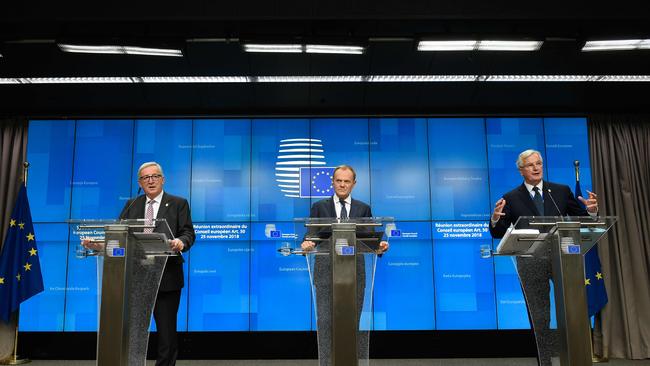What happens now? A tragic’s guide to Britain’s exit from EU

WHAT HAPPENS NOW?
British Prime Minister Theresa May is to embark on a two-week campaign to sell her deal to MPs and the public at large. That kicked off last night with a cabinet briefing and then a statement to the House of Commons on the deal.
Regional trips by Mrs May are also planned to hammer home the message that this is the only deal on offer, it cannot be renegotiated and failure to agree to it would be, in the words of Mrs May, to plunge Britain into “division and uncertainty”.
HOW WILL SHE GO ABOUT TRYING TO SELL THE DEAL TO MPs?
Much of the hard work will be done behind the scenes in Westminster.
Downing Street and government whips will attempt to whittle down the 80-plus Tories who don’t like the deal and are threatening to vote against it. As well as the usual personalised inducements and threats the strategy is to persuade MPs that a vote against the deal is not “risk-free” and that it could result either in a second referendum or no deal at all. To that end the government will publish in the coming days some fairly apocalyptic Treasury analysis of the effects of no deal (and the economic upsides of the deal) as well as a white paper setting out an immigration system after Brexit.
IF MAY WINS THE MEANINGFUL VOTE, IS THAT IT?
No. The government also has to get the withdrawal agreement passed into British law before the end of March for the deal to be binding. Rebels on both sides will use the legislation to try to bind the government’s hands — for example by saying that the agreement can be ratified only if it has been agreed by a second referendum. However, if the meaningful vote has passed, it probably means that Mrs May has the numbers to get the deal through the Commons and many amendments would be seen as “wrecking clauses” that the government would argue, if passed, could result in a last minute chaotic no-deal exit.
WHAT HAPPENS AFTER THAT?
Assuming that the legislation is passed, Britain will leave the EU at 11pm on March 29 and immediately move into the 21-month transition period.
That is really where the hard work starts. In fact more British officials will probably spend more time in Brussels after we have left the bloc than before. Britain and the EU will have to try to negotiate a legally binding trade and security treaty and answer many of the politically toxic questions that have been left still unresolved.
WHAT ARE THE ISSUES STILL TO BE RESOLVED?
These include how to avoid a hard border in Northern Ireland without a Customs Union; how far Britain ties itself into future EU rules and regulations to get access to European markets; how much access to give EU fishermen to British markets; and what kind of contributions Britain will have to make. All this will have to take place against a backdrop of the non-existent Tory majority and an impending general election in 2022.
There will be six-monthly meetings between the Prime Minister and European Commission president to assess progress with a deadline of July 2020. If the future trade deal is not ready by then, and most believe it will take far longer, Britain will be faced with a choice of extending the transition by a year or two years or entering a backstop Customs Union that it may find difficult to escape from.
On top of all this, Britain will be trying to change the EU’s so-called “equivalence” rules on financial services and to negotiate a complete security treaty, including sensitive access to European police databases and defence projects such as the Galileo space program.
The Times


